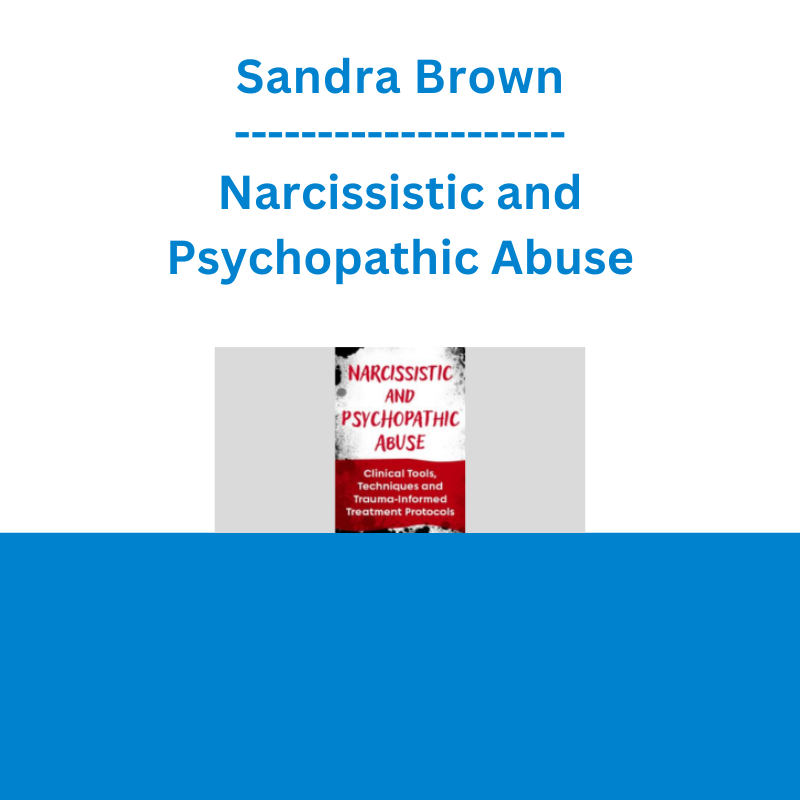*** Proof of Product ***
Exploring the Essential Features of “Sandra Brown – Narcissistic and Psychopathic Abuse: Clinical Tools, Techniques and Trauma-Informed Treatment Protocols”
Speaker: Sandra L. Brown, MA
Duration: 19 Hours 59 Minutes
Format: Audio and Video
Copyright: Mar 13, 2023
Media Type: Digital Seminar
Description
This comprehensive training module is intended to be a main component in a larger Narcissism Certification course. The content inside covers how to treat survivors of narcissistic abuse from a trauma-informed perspective.
Speaker
Sandra L. Brown, MA, has worked with narcissistic abuse survivors for over 30 years and is often referred to as the pioneer in the field of pathological love relationships (relationships with partners who have narcissism or psychopathy). Her seminal work and research helped launch the ‘Narcissistic and Psychopathic Abuse’ field. She is an author of hundreds of articles for survivors on narcissistic abuse and her books include the highly popular How to Spot a Dangerous Man Before You Get Involved (Hunter House, 2005), the award-winning Women Who Love Psychopaths: Inside the Relationships of Inevitable Harm With Psychopaths, Sociopaths & Narcissists (Mask Publishing, 2018), as well as the clinically-relevant Counseling Victims of Violence (American Counseling Association, 1991). She is the current president of The Association for NPD/Psychopathy Survivor Treatment, Research & Education, and the CEO of The Institute for Relational Harm Reduction and Public Pathology Education.
Speaker Disclosures:
Financial: Sandra Brown has employment relationships with the Institute for Relational Harm Reduction & Public Pathology Education and the Assn for NPD/Psychopathy Survivor Treatment, Research & Education. She receives royalties as a published author. Sandra Brown receives a speaking honorarium and recording royalties from PESI, Inc. She has no relevant financial relationships with ineligible organizations
Non-financial: Sandra Brown has no relevant non-financial relationships.
Objectives
- Identify survivors of narcissistic abuse and differentiate between historical and non-historical trauma clients.
- Assess the specific treatment needs of survivors of narcissistic abuse and differentiate between treatment seeking and treatment needs.
- Apply best practices for harm reduction in trauma treatment.
- Develop a three-step protocol for trauma education during stabilization.
- Apply pacing and titration in stabilization and symptom management.
- Use questionnaires, topic lists, and psychoeducation tools for the assessment and treatment of survivors of narcissistic abuse.
- Implement pathology education in the Structured Session Method.
- Evaluate the neuroscience and neurobiology of personality disorders in relation to survivors of narcissistic abuse.
- Utilize specialized techniques for enhancing pathology education and pathology education topic lists.
- Identify the six must-teach concepts for pathology education and use the “link and label” technique for teaching.
- Differentiate between generalized cognitive dissonance (CD) and chronic and persistent CD.
- Identify the four identifiers of CD and complications of trauma and CD.
- Develop best practices for CD reduction and utilize checklists, charts, and mindfulness scripts.
- Differentiate between typical trauma and atypical trauma and understand the presentation of hyper and hypo arousal states with CD.
- Utilize trauma assessments and differentiate between dual dysregulation and presentation/hyper and hypo arousal states with CD.
- Assess the impact of survivors’ super traits of personality and understand the risks associated with agreeableness and conscientiousness.
- Develop strategies for working with super traits in early work and later work, using the historical impact checklist and super trait education topic list.
- Evaluate the patient intake and assessment process, including prescreening tools and considerations, special screening features, and trauma assessments for survivors of narcissistic abuse.
Outline
Introduction and Goals of Treatment
Who Are You Treating? — A Survivor Overview
- Problems in Identification
- Historical Trauma and Non-Historical Trauma clients
- Differentiation in Treatment Seeking and Treatment Needs
- Overall Specific Treatment Needs of Survivors
Intervention/Harm Reduction, Trauma Psychoeducation and Skill Building for Stabilization
- Early Recovery and the Stabilization Process
- Eight Important Aspects in Early Treatment—Best Practices
- Prior Treatment Failure
- Intervention for Harm Reduction and Trauma Worsening
- Three Step Protocol
- Structuring for Multi-Need Clients
- Trauma Education in Stabilization
- Skill Building, Resourcing, and Symptom Management in Stabilization
- Pacing and Titration in Stabilization
- Questionnaires, topic lists, and psychoeducation tools
Pathology Education for Stabilization/Cognitive Dissonance Reduction
- Implementing Path Ed in The Structured Session Method
- Neuroscience and Neurobiology of PDs
- Specialized Techniques for Enhancing Pathology Education
- Pathology Education Topic Lists
- Six Must Teach Concepts
Checklists and the “Link and Label” technique
Cognitive Dissonance (CD): The Hallmark Feature of Pathological Love Relationships
- Generalized CD versus Chronic and Persistent CD
- CD Etiology, Levels and Focuses
- Four Identifiers of CD
- Complications of Trauma and CD
- The Onset of Dual Dysregulation
- Behaviors Connected to CD
- Eight Best Practices for CD Reduction
- Checklists, charts and Mindfulness scripts
Working with Typical and ‘Atypical’ Trauma in Treatment
- Trauma Assessments: Trauma Interviews and Self-Reports
- Differentiation Between Typical Trauma and Atypical Trauma
- Dual Dysregulation and Presentation/Hyper and Hypo Arousal States with CD
- Destabilization and Dysregulation
- Trauma, Cognitive Dissonance and the Window of Tolerance
- Triggers in Dual Dysregulation
- Neuro-Based Treatment Issues from Dual Dysregulation
- Combination Problems of Executive Functioning, Dual Dysregulation, and CD
- Memories and CD and Processing Issues
- Working with Whole Memories or Dual Processing
- Using the C-PTSD and Atypical PTSD© checklist
Survivor’s Super Traits of Personality—A Different Kind of Risk Management
- How Personality Science Can Help Us Understand These Survivors
- Wrong But Common Therapeutic Assumptions About These Survivors
- Understanding High/Low ACE Scores
- Commonalities in Research: Two Trait Elevations
- Risk in the Traits of Agreeableness and Conscientiousness
- Harm Avoidance as a Dimension of Anxiety
- Super Traits versus Codependency
- Working with Super Traits: Early Work and Later Work
- Historical impact checklist, super trait education topic list and more
Patient Intake and Assessment
- Prescreening Tools and Considerations
- What to Use to Identify a Pathological Love Relationship
- Tele-Counseling Considerations
- Intake Package and Special Screening Features
- Trauma Assessments
- Atypical PTSD and Cognitive Dissonance Checklists
- The ACE
- The Partner-Related Traits Pathometry Checklist©
Target Audience
- Counselors
- Social Workers
- Psychiatrists
- Psychologists
- Case Managers
- Addiction Counselors
- Therapists
- Marriage & Family Therapists
- Psych Nurses
- Other Mental Health Professionals
Please see the full list of alternative group-buy courses available here: https://lunacourse.com/shop/










 Chris Capre - Advanced Price Action Ongoing Training & Webinars
Chris Capre - Advanced Price Action Ongoing Training & Webinars  Crypto Dan - The Crypto Investing Blueprint To Financial Freedom By 2025
Crypto Dan - The Crypto Investing Blueprint To Financial Freedom By 2025  Julie Stoian & Cathy Olson - Launch Gorgeous - Funnel Gorgeous Bundle
Julie Stoian & Cathy Olson - Launch Gorgeous - Funnel Gorgeous Bundle  Jesse Livermore Trading System - Joe Marwood
Jesse Livermore Trading System - Joe Marwood  Simpler Trading - Bruce Marshall - The Options Defense Course
Simpler Trading - Bruce Marshall - The Options Defense Course  Matan Feldman - The 13-Week Cash Flow Modeling - Wall Street Prep
Matan Feldman - The 13-Week Cash Flow Modeling - Wall Street Prep  The Daily Traders – Exclusive Trading Mentorship Group
The Daily Traders – Exclusive Trading Mentorship Group  Sovereign Man Confidential - Renunciation Video
Sovereign Man Confidential - Renunciation Video  Dave Landry - Stock Selection Course
Dave Landry - Stock Selection Course  Forexmentor - Recurring Forex Patterns
Forexmentor - Recurring Forex Patterns  Racing Workshop - Complete Online Package
Racing Workshop - Complete Online Package  Trade Like Mike - The TLM Playbook 2022
Trade Like Mike - The TLM Playbook 2022  SMB - Options Training
SMB - Options Training  Money Miracle - George Angell - Use Other Peoples Money To Make You Rich
Money Miracle - George Angell - Use Other Peoples Money To Make You Rich  Greg Loehr - Advanced Option Trading With Broken Wing Butterflies
Greg Loehr - Advanced Option Trading With Broken Wing Butterflies  Emanuele Bonanni - My Trading Way
Emanuele Bonanni - My Trading Way  Candlecharts - Frontline Forex Vol 1-3
Candlecharts - Frontline Forex Vol 1-3  Team NFT Money - Ultimate NFT Playbook
Team NFT Money - Ultimate NFT Playbook